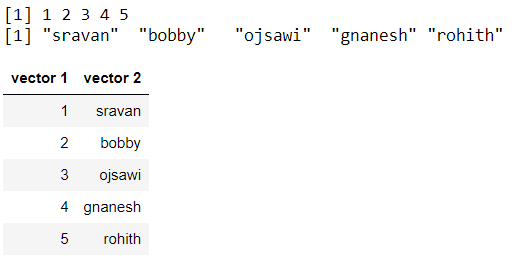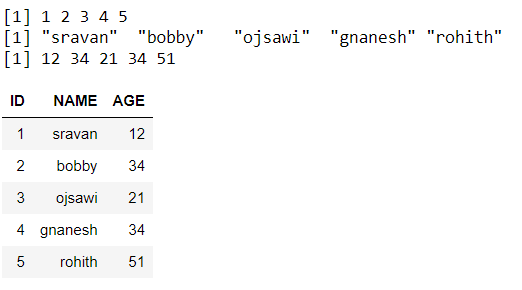R语言 使用cbind函数时设置列名
在这篇文章中,我们将看到如何在R编程语言中使用cbind()函数来设置列名。
让我们创建并合并两个向量进行演示。
# create two vectors with integer and string types
vector1 = c(1,2,3,4,5)
vector2 = c("sravan","bobby",
"ojsawi","gnanesh",
"rohith")
# display
print(vector1)
print(vector2)
# combine two vectors using cbind()
print(cbind(vector1, vector2))
输出
[1] 1 2 3 4 5
[1] "sravan" "bobby" "ojsawi" "gnanesh" "rohith"
vector1 vector2
[1,] "1" "sravan"
[2,] "2" "bobby"
[3,] "3" "ojsawi"
[4,] "4" "gnanesh"
[5,] "5" "rohith"
方法1:使用colnames()函数设置列名
R语言中的colnames()函数用于为矩阵的列设置名称。
语法:
colnames(x) <- value
参数:
x: 矩阵
value: 要设置的名称向量
例子: 使用colnames()函数来设置列名的R程序。
# create two vectors with integer and string types
vector1 = c(1,2,3,4,5)
vector2 = c("sravan","bobby","ojsawi",
"gnanesh","rohith")
# display
print(vector1)
print(vector2)
# combine two vectors using cbind()
combined = cbind(vector1,vector2)
# Applying colnames
colnames(combined) = c("vector 1", "vector 2")
# display
combined
输出
方法2:在cbind()函数中设置列名
在这里,我们必须在cbind()函数本身中给出列名。
语法: cbind(column_name = data1, column_name= data2,………,column_name=data n)
其中
- data 是要结合的输入数据
- column_name 是新的列名。
例子: 在cbind()函数中为三个向量设置列名的R程序
# create three vectors with integer and string types
vector1 = c(1,2,3,4,5)
vector2 = c("sravan","bobby","ojsawi",
"gnanesh","rohith")
vector3 = c(12,34,21,34,51)
# display
print(vector1)
print(vector2)
print(vector3)
# combine three vectors with in cbind() function
combined = cbind("ID"=vector1,
"NAME"=vector2,"AGE"=vector3)
# display
combined
输出
 极客教程
极客教程
